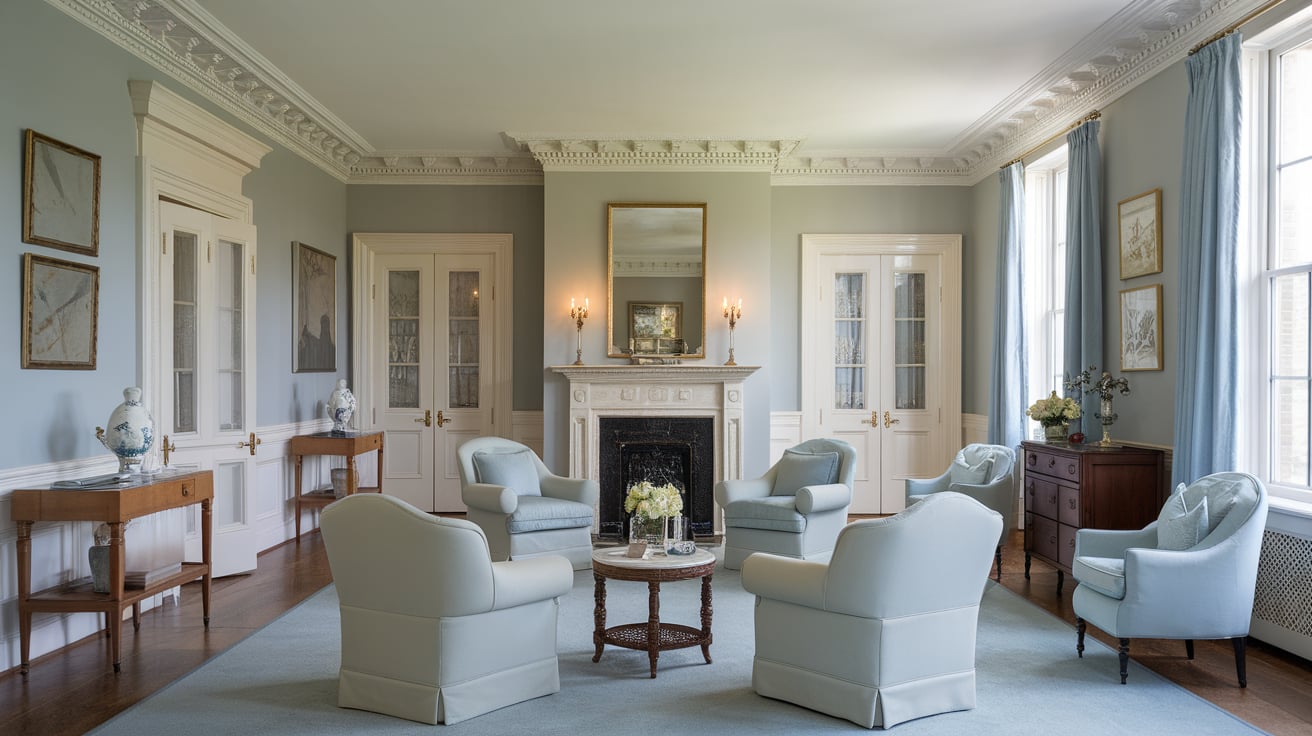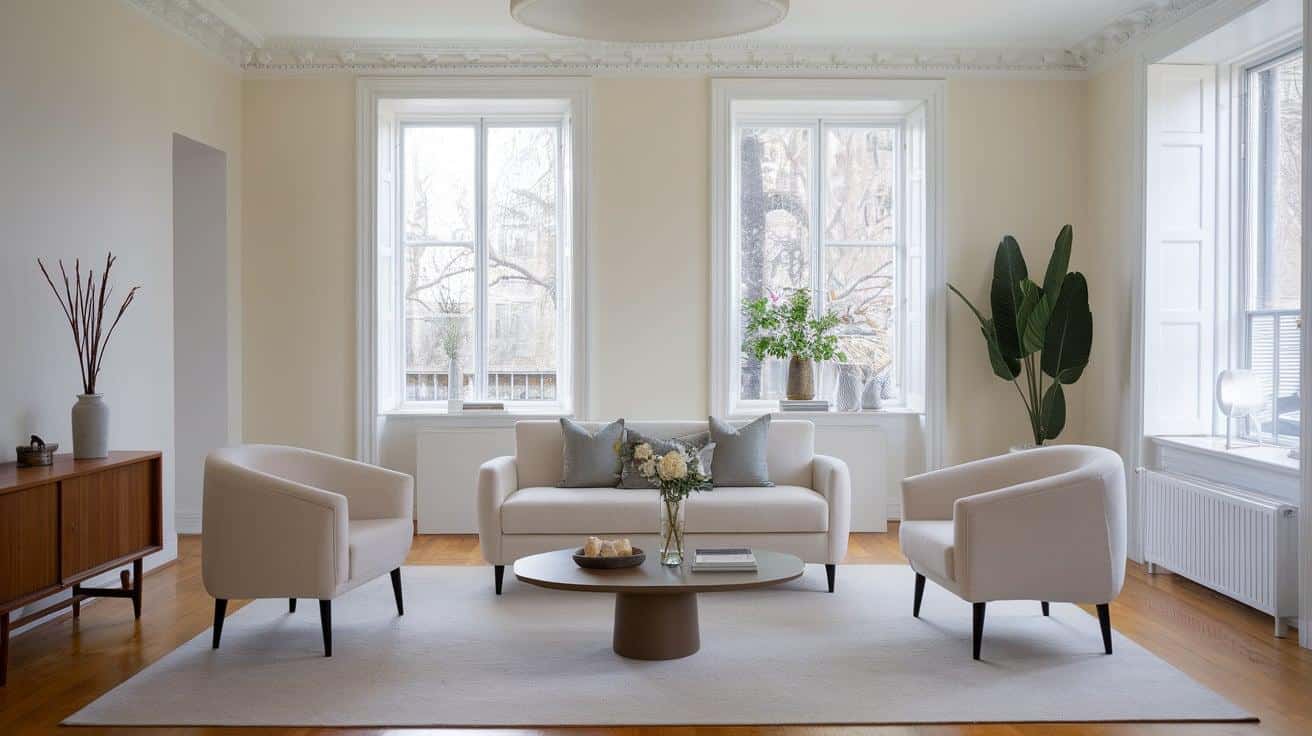Many homeowners struggle to find a design style that feels both classic and fresh.
Georgian interior design offers this perfect mix, with its focus on order and visual charm, that still works today.
I promise that by understanding Georgian design basics, you can create spaces that look put-together without feeling stuffy or old-fashioned. This design approach brings comfort and class to any home.
This article will walk you through the key parts of Georgian design: the balance and symmetry that create order, the quality materials and furniture that add substance, the colors and details that build character, and how to mix these ideas into today’s homes for a look that lasts.
Classic Beauty and Harmony of Georgian Interior Design
- Proportion and Balance in Design:
Georgian interiors are designed for balance. Every element, from wall height to window size, is carefully planned to create harmony and order, ensuring each space feels proportioned and comfortable. - The Role of Symmetry in Georgian Rooms:
Symmetry is key in Georgian design. Furniture is often paired, windows face each other, and light fixtures are evenly spaced to create a balanced and orderly feel throughout the room. - Enhancing Visual Appeal Through Symmetry:
Symmetry creates visual appeal by satisfying our sense of balance. It guides the eye smoothly across the room, making the space feel cohesive. Using symmetrical items like lamps or artwork can bring this calm, ordered feel to modern spaces.
Rich Materials and Classic Furnishings Georgian Interior
1. Luxurious Materials in Georgian Interiors
Georgian interiors feature high-quality materials that stand the test of time. Mahogany wood brings warmth to furniture; marble adds class to fireplaces and tables, and silk and velvet cover chairs and drapes.
These materials weren’t just pretty. They showed status and good taste. The natural shine of brass and gold details catches the eye without being too showy.
2. Key Furniture Pieces of the Era
Georgian rooms center around statement pieces that mix function with beauty. Wing chairs with curved arms offer comfort from the fire. Tallboy Chests stores items while showing off fine wood grain.
Drop-leaf tables save space when needed. Four-poster beds create drama in bedrooms. China cabinets display fine dishes. Each piece stands on its own while working with others.
3. The Impact of Craftsmanship and Detail
The fine work on Georgian furniture sets it apart from other styles. Look for ball-and-claw feet on chairs and tables. Notice the carved shells above doors. See how chair legs curve just so. Every joint fits perfectly.
Wood gets hand-polished until it glows. These small touches show care and skill. Modern mass-made items can’t match this level of handwork and attention.
Iconic Georgian Color Palettes
Georgian homes use specific color choices that create a distinct mood and feeling. These color schemes remain useful for modern homes seeking a timeless look.
- Soft Base Colors: Walls in Georgian homes often wear light tones such as pale blues, gentle greens, and soft pinks. These quiet colors create a calm background that feels clean and fresh.
- Crisp Trim Contrast: White or cream trim stands out against colored walls, adding clear lines that define doors, windows, and ceilings. This contrast brings structure to rooms.
- Warm Wood Tones: Mahogany furniture adds warmth through its rich brown color. These deeper tones help ground spaces and prevent them from feeling too cool or distant.
- Bold Accent Colors: Deeper shades like burgundy, navy, and forest green appear in smaller doses through fabrics and rugs. These stronger colors add focus points without taking over.
- Mood Effects: The color mix in Georgian rooms creates a feeling that’s both proper and comfortable. The light walls feel open and welcoming, while darker accents add depth and interest.
- Room-Specific Colors: Different rooms might use distinct colors based on their purpose – dining rooms might use richer tones to feel more formal, while bedrooms stick to softer shades for rest.
Influence of Georgian Design on Modern Interiors
1. The Lasting Influence of Georgian Design Principles
Georgian design ideas still shape how we create homes today. The focus on balance and symmetry helps modern rooms feel orderly and calm.
Clean lines and simple shapes work in today’s spaces as well as they did centuries ago. Many current design trends pull from these old ideas without people even knowing it.
The Georgian love of natural light through big windows fits perfectly with today’s bright, open homes. These time-tested rules help make spaces that feel good to live in.
2. Examples of Georgian-Inspired Modern Interiors
Today’s homes often mix Georgian touches with newer styles. White kitchens with inset cabinets and brass pull drawn from Georgian order. Living rooms with matched sofas and centered coffee tables use Georgian balance.
Modern bedrooms with symmetrical lamps and artwork follow this tradition, too. Even minimal spaces use Georgian ideas when they balance items.
These homes feel current while using proven design methods from the past.
3. Blending Traditional and Modern Elements
The most appealing spaces today mix old and new with purpose. For example, a room might pair a modern sofa with Georgian-style side tables. Light fixtures can update a space, while trim work keeps it grounded.
Current paint colors on walls with classic moldings create perfect tension. The key is finding a balance between styles rather than copying one time period. This mix gives homes personality and keeps them from feeling dated or too trendy.
Use of Natural Light in Georgian Interiors
Georgian homes cleverly use window placement to fill rooms with sunlight. Large, tall windows are a key part of this design style, often placed in pairs or groups to create a sense of balance.
- Window Placement Matters: Windows in Georgian homes are placed at set distances apart, allowing light to spread evenly across rooms. This careful spacing helps create the feeling of order that defines Georgian spaces.
- Bright, Open Feeling: The generous size of Georgian windows allows maximum daylight to enter rooms. This natural brightness makes spaces feel larger and more open.
- Light Reflection: Light-colored walls in pale blues, greens, and creams help bounce sunlight throughout the room. This thoughtful use of color works with the natural light to create a bright, airy feeling.
- Connection to Outdoors: Window placement often considers views of gardens or streets, forming a link between indoor and outdoor spaces. This connection to nature adds depth to the home’s feel.
- Evening Illumination: When daylight fades, Georgian rooms use wall sconces and chandeliers placed in balanced patterns to maintain the even lighting pattern established by the windows during the daytime.
Conclusion
Georgian design wisdom still offers value to today’s homeowners. The focus on balance, quality materials, and thoughtful details creates spaces that feel both ordered and comfortable.
By understanding classic Georgian elements like symmetrical layouts, light-enhancing color schemes, and careful craftsmanship, you can bring these time-tested ideas into modern living.
The beauty of Georgian design lies in its lasting appeal. These principles have worked for centuries because they tap into our basic desire for harmony and proportion.
Whether you add small touches like matched lamps or fully embrace Georgian styling with detailed moldings and formal furniture arrangements, these ideas help create homes that feel good to live in.
Georgian design teaches us that good taste isn’t about following trends but about understanding what makes spaces feel right.












